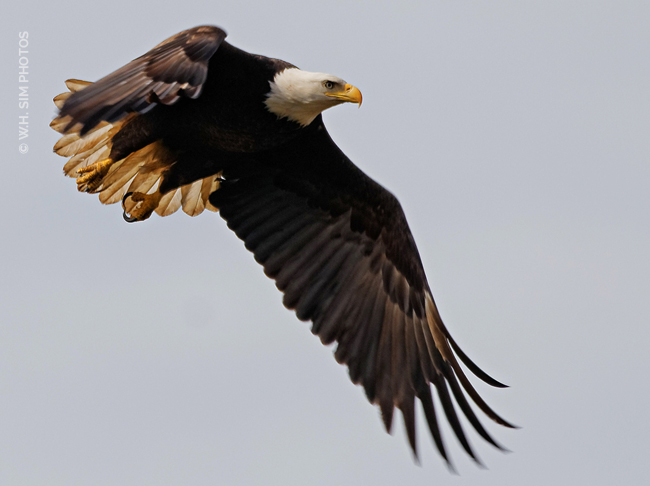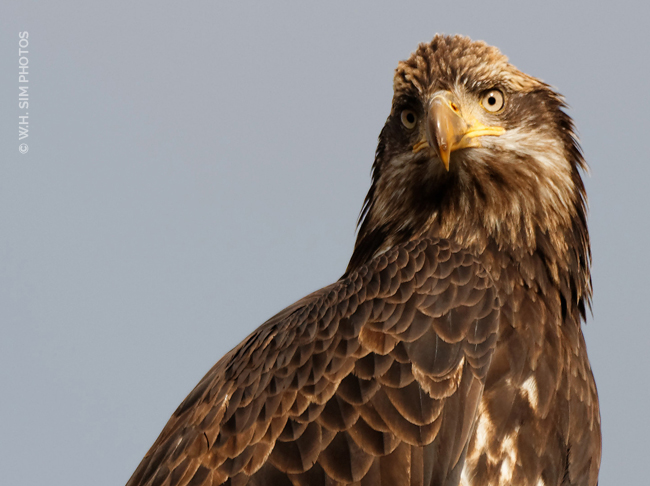This gallery contains 4 photos. I wanted to have a closeup of this fully mature Bald Eagle roosting at the top a dead birch tree on the Raptor Trail portion of Boundary Bay Regional Park … but it decided, at 30 feet away, that it was time to go. This was the most dramatic part of its takeoff. Photographed on April 15.
 flight of the Bald Eagle, taken on an overcast day at Boundary Bay Regional Park.
flight of the Bald Eagle, taken on an overcast day at Boundary Bay Regional Park.
f/8, 1/500, 150-500mm telephoto lens, 500mm, ISO 100
A Bald Eagle (perhaps a third or very early fourth year) sits on a power line on a low traffic road. Taken on our way through Ladner, where we encountered at least 30 Bald Eagles within a 3 mile radius (three trees held at least 5-7 eagles each)! Photographed on January 28.
 a bird on a wire in Ladner calmly regards me from 20 feet off the ground.
a bird on a wire in Ladner calmly regards me from 20 feet off the ground.
f/6.3, 1/500, 150-500mm telephoto lens, 500mm, ISO 100
You can see just how young this Bald Eagle is (perhaps a second year) — the beak is still dark, and there is a distinct lack of white feathers on its head. This magnificent creature was drawing a small crowd of admirers at Boundary Bay Regional Park, near the pump house outflow. Still some 25-30 feet away from my lens, this juvenile was content to stand in the shallow water for quite some time, while around it slowly gathered Glaucous-Winged Gulls, Mew Gulls, and Green-Winged Teal ducks, going about their business as if a fierce predator wasn’t in their midst. Photographed on Feb 28 a very sunny and busy day at the beach.
 a sub-adult draws the crowds near the pumphouse at Beach Grove/Boundary Bay Regional Park.
a sub-adult draws the crowds near the pumphouse at Beach Grove/Boundary Bay Regional Park.
f/8, 1/1600, 150-500mm telephoto lens, 500mm, ISO 400
A first-year Bald Eagle sits in a tree no more than 15 feet above our heads. It has not yet learned that its personal space should be much, much more than that (which is good news for the admiring crowd of humans below it), and sat there for at least an hour–ignoring the other, much smaller birds that chirped and flew around Elgin Heritage Park. The beak–which is predominantly black–and the very brown head–with white stippling the ends of its head and neck feathers–are indicators of just how young this fledged Bald Eagle is. Photographed on February 15.
 a juvie sits no more than 15 feet above our heads in a tree at Surrey’s Elgin Heritage Park
a juvie sits no more than 15 feet above our heads in a tree at Surrey’s Elgin Heritage Park
f/9, 1/250, 150-500mm telephoto lens, 500mm, ISO 400
MY ZAZZLE WEBSITE www.zazzle.com/walkswithnature
MY PIXELS.COM WEBSITE pixels.com/profiles/hui-sim.html

Wonderful pictures, what a delight to look at those magnificent birds through your camera lens.
LikeLiked by 2 people
thank you, Susan! glad you enjoyed them!
LikeLike
Foto stupende, meravigliose. Che gioia per gli occhi!!!
Complimenti. Ciao, Pat
LikeLiked by 1 person
many thanks, Pat!
LikeLike
There is nothing so bold as a bald eagle – love your pics!!
LikeLiked by 1 person
thank you, Sarah!
LikeLike
Nice photos, as always!
LikeLiked by 1 person
thank you, Steve!
LikeLiked by 1 person
Wonderful, wonderful photos! Your touring explanations are very helpful. I know practically nothing about bald eagles. Until now! “-)
LikeLiked by 1 person
thank you, Jan! glad you found this post informative and entertaining! 🙂
LikeLiked by 1 person
Wonderful shots. I am often impressed by the lack of fear in young animals who haven’t (sadly) learned that humans are not to be trusted.
LikeLiked by 1 person
so true, Eliza. unfortunately, not all humans can be trusted to respect wildlife. 😦
I have to remind myself that although it may be frustrating when they do scatter, it’s nothing personal. flight or fight can be the difference between life and death.
LikeLiked by 1 person
All the shots are wonderful, but there is something especially striking about the one standing in the water.
LikeLiked by 1 person
I have seen them sitting on the ice floes in winter when the tides are really low (they are so far out that they are postage stamp sized blips), but never before so near and sitting in shallow waters!
LikeLiked by 1 person
Your photos are like chocolate for my soul! What magnificent shots. Such detail! I especially love the one flying and the one in the water! Wow!
Um, technical question – your 150-500mm lense – is it one of those really wide ones? I have one that goes to 300mm and it just isn’t enough. My husband’s point and shoot does a better zoom job. Do you always use a tripod? They seem so big and heavy!
LikeLike
hello there!
my 150-500mm lens is a long telephoto lens (it has a long focal length; that is, it extends far out from the camera body, and will get you plenty of looks and comments from other people); they’re generally for wildlife photography, as our subjects (birds, bears, deer, etc.) are often far away. 500mm, 600mm, 800mm, 1000mm, and 1500mm lenses are considered super long telephoto lenses (in fact, they they look like telescopes) and can be quite heavy (my long lens is 4 lbs but some can weigh up to 25 lbs). tripods are highly recommended, even with optical image stabilization, because it is not easy to shoot (particularly moving objects like a flock of birds in flight) with a steady hand.
I don’t use the tripod, as a rule, unless I’m reasonably sure my subject will not move (e.g. when I’m shooting the full moon on a clear night), because a tripod can add another 5-7 more lbs; it’s extra weight to carry around and/or assemble. with my telephoto lens (~ 4 lbs) and my camera body (~ 2 lbs), adding a tripod can make the weight go up to 13 lbs or higher — and I may carry other camera accessories around.
wide angle lenses (14mm, 24mm, 35mm, etc. — short focal lengths) are short lenses (that is, they don’t extend far out from the camera body) for shooting landscapes (and even portraits of people) where you want to capture a lot of image in the frame.
your husband’s point-and-shoot camera sounds like one of the super zoom variety. point-and-shoots, as a rule, are compact models with non-interchangeable lenses; you can’t swap the (built-in lens) for another lens, like you can with a DSLR camera like the Canon EOS 6D or Nikon D810 (so you’re stuck with the “factory” focal length). but, with super zooms like the Nikon Coolpix P900 you have a 83X zoom lens, which is roughly equivalent to 24-2000mm. you also have massive depth of field (that is, everything from foreground to midground and background — are sharp).
but because the image sensors on point-and-shoots are MUCH smaller than those on DSLR cameras (typically 1.75mm vs 35mm), the quality of images taken with a full frame DSLR cameras will be significantly better. smaller image sensors, however, mean that super zooms are much more compact, weigh less, and easier on the pocketbook.
see this link for more information on wide angle lenses:
http://photography.tutsplus.com/articles/a-beginners-introduction-to-wide-angle-photography–photo-3765
hope this helps! cheers,
Hui
LikeLiked by 1 person
Wow, thanks a lot! I have a Nikon D330. I have a wide angle that it came with, a macro and a 100 – 300mm zoom. I just want more zoom for wildlife. I have opportunity to see a lot of wildlife I want to shoot, but a bit too far away. I just need to weigh (haha pun) the advantage of bigger zoom with how heavy it is. Holding it steady is a challenge for me anyway. Thank again!
Mary
LikeLiked by 1 person
you’re welcome, Mary!
LikeLike
Compliments, they are superb The bald eagles,
beautiful photographic work …
I wish you a good day.
LikeLiked by 1 person
thank you, Hervé!
LikeLiked by 1 person
It’s always a thrill to see eagles (bald, golden) but even more of a thrill when I get to see them up close in gorgeous photos! Love these shots!
LikeLiked by 1 person
thank you, Teresa! 😀
LikeLiked by 1 person
Maybe young, but still impressively regal. Your photos provide us with something we would never see on our own, so thank you! We have a bald eagle nesting area not to far from here on Jordan Lake. It’s protected.
LikeLiked by 1 person
it’s hard to believe that DDT almost wiped out the Bald Eagles in the 70s. we have some many of them over here!
LikeLike
Fantastic shots! The adult looks so dramatic and mighty, but the younger ones look much more friendly 🙂 I’ve never been able to get this close to Bald Eagles, only seen them in flight.
LikeLiked by 1 person
thank you, Tiny! even the adult Bald Eagles are somewhat used to the sight of humans here. 🙂
LikeLike
Just beautiful 🙂
LikeLiked by 1 person
thank you, Elle!
LikeLiked by 1 person
Stunning! I have seen bald eagles only from a distance.
LikeLiked by 1 person
we get a bit spoiled in Metro Vancouver because they are quite comfortable around humans.
LikeLiked by 1 person
Yes indeed, I too saw them in the trees in the middle of a farm, but it was far from the main road.
LikeLike
Nice pictures for sure. Eagles come out of nowhere as do hawks so I never get pictures. They do congregate in the Annapolis valley, NS in the winter and are fed there with chicken scraps I believe. Always cool to see them floating above. The crows don’t like it though and will chase them away. I often notice them on the side of the road due to the white patch or flight style. Young gulls are also darkish I believe.
LikeLiked by 1 person
the crows definitely harass the Bald Eagles here, and some of the smaller birds will do that as well if they have a nest to protect — I have seen a Rufous hummingbird (successfully) harass a Bald Eagle this summer! 🙂
LikeLike
Sweet tale. Love it when David beats Goliath. Like cat beating out dog no problem.
LikeLiked by 1 person
yes, and speaking of turned tables … I saw that video of the cat defending her human family against a dog! 🙂
LikeLike
Wonderful .. Such a handsome regal bird.
LikeLiked by 1 person
thank you, Julie! 🙂
LikeLiked by 1 person
Loving all of these, especially the last two. There is something majestic about these birds.
Kath.
LikeLiked by 1 person
thank you, Kath! it’s that stern look and proud profile. 🙂
LikeLike
Its also a real pleasure seeing them high up in the blue sky too.
LikeLiked by 1 person
oh yes! I envy them their ability and freedom of flight. 🙂
LikeLiked by 1 person
Oh wow!!! This bird is so impressive, and so are your photographs! Beautiful!
And that lens, seems to be quite sharp!
Kind regards,
Tieme
LikeLiked by 1 person
thank you, Tieme!
LikeLiked by 1 person